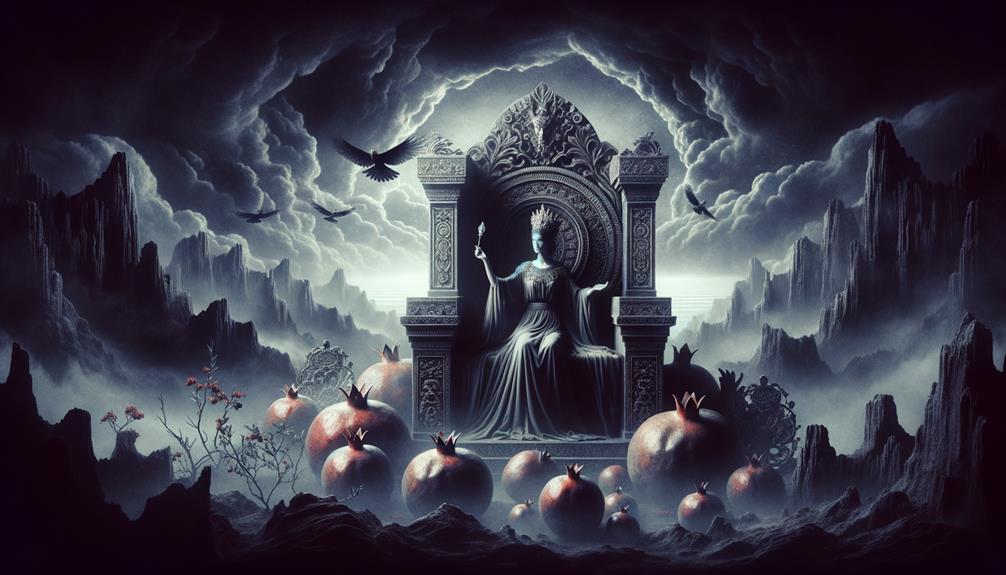If you're into Greek mythology like I am, you'll find Persephone quite a character. She's known as the Queen of the Underworld, sharing her rule with Hades, her other half. This gives her a unique dual role. On one hand, she brings life with the arrival of spring, and on the other, she governs the realm of death.
Her story is a potent metaphor for life's inevitable cycles – life, death, and rebirth. It's a testament to her resilience and strength in facing challenges. I think digging deeper into her story can offer us some pretty cool philosophical insights. What do you think? Should we dive in deeper?
Persephones Mythological Origin
Let's chat about Persephone's mythic roots. She's the daughter of Zeus and Demeter and holds the title of the Queen of the Underworld. As the Greek goddess who controls both spring fertility and the harsh underworld, she's a fascinating character in Greek mythology, symbolizing both life and death. Her story explains why we have different seasons – a concept closely tied to the Earth's fertility. When she's with Hades in the underworld, the Earth goes through its barren seasons, reflecting Demeter's sorrow over her daughter's kidnapping. But when she comes back, it's like the Earth is celebrating with blossoming spring, a sign of rebirth. So, her story is actually about the cycle of nature's death and rebirth, showing us how the ancient Greeks saw a deep connection between the divine and the earth.
The Abduction by Hades
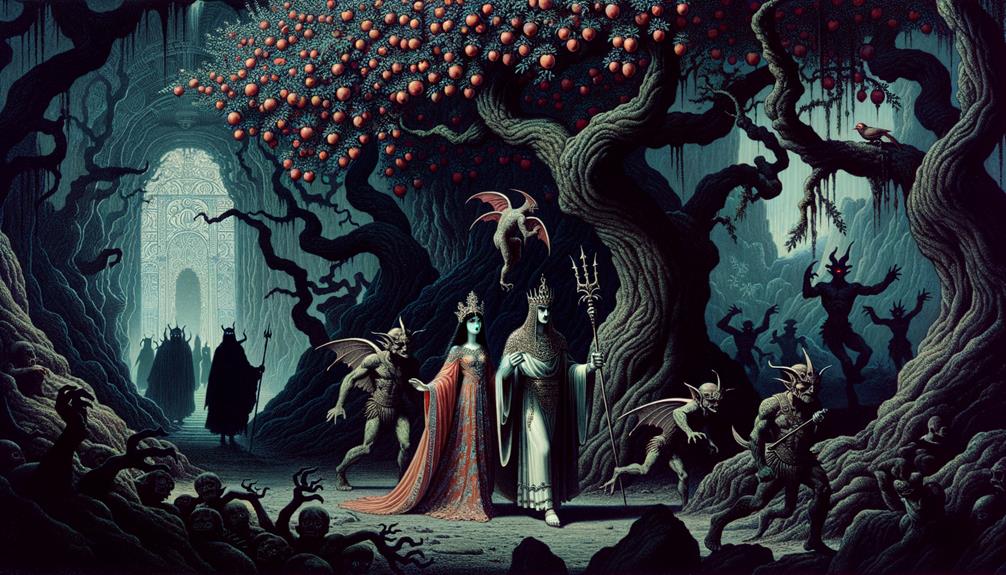
Alright, let's chat about a key episode in Persephone's life – the time she was taken by Hades, ruler of the Underworld. Picture her, just a girl out in the Sicilian fields, minding her own business and gathering flowers. That's when Hades, struck by her beauty, decided to whisk her off to his underworld kingdom to rule by his side.
This act sparked a desperate search by her mother, Demeter, the goddess in charge of the harvest. When she couldn't find her precious daughter, Demeter's grief caused the crops to fail and winter to descend, which explains the change of seasons in Greek mythology.
As the crisis escalated, Zeus, who was the big boss of the gods, had to step in. He tasked Hermes with sorting out the situation and negotiating Persephone's freedom. But, as we'll find out, getting back to the surface world wasn't going to be straightforward.
Persephones Dual Role
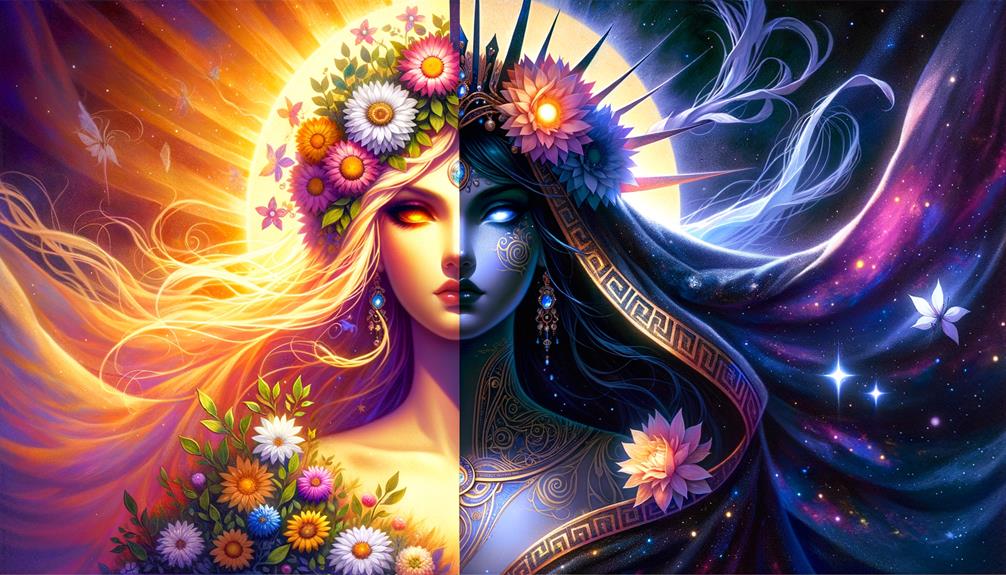
Persephone, a key character in Greek mythology, wears two hats – she's not only the Queen of the Underworld but also the Goddess of Spring. This dual role makes her a symbol of life and death. She's the child of Demeter and her life plays out across two different realms, establishing a subtle equilibrium.
- As the Queen of the Underworld, she holds sway over the spirits of those who have passed on.
- Back on Earth, she takes on the role of the Spring Goddess, encouraging growth and abundance.
- Her presence in both these worlds reflects the circle of life, showing how death and birth are linked.
Persephone's dual roles highlight the intricate relationship between life and death, a notion that's as intricate as it is foundational.
Worship and Rituals
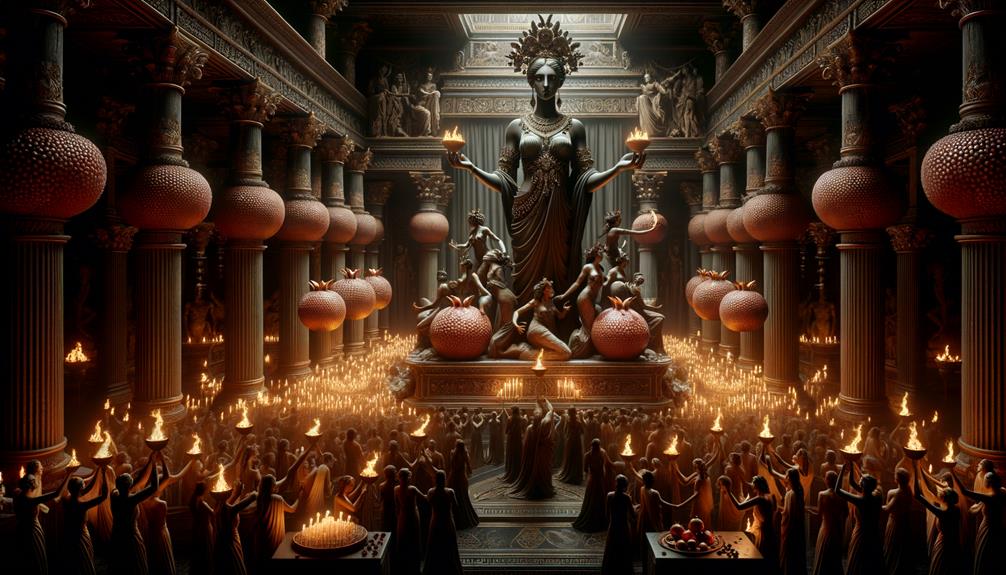
If you take a journey into the spiritual world of ancient Greece, you'll find Persephone, a figure of great importance. Her story, which beautifully intertwines life, death, and fertility, is a key part of various cultural rituals. One of the most significant of these was the Eleusinian Mysteries, a ceremony that celebrated rebirth and renewal.
Persephone wasn't limited to this event, however. She played a vital role in many other ceremonies throughout Greece, each one showcasing a unique interpretation of her story. Despite the differences, the common thread was the deep respect and honor given to Persephone.
Her influence didn't end with the ancient Greeks. The story of Persephone continues to be told and retold, shaping our cultural understanding of life's ups and downs. The reverence for her is not just about religious practices; it's about how the Greeks viewed life itself – a constant cycle of growth, decay, and rebirth.
Persephone's impact still holds true today, standing as a testament to her timeless significance in our collective understanding of the world. So, the next time you hear her name, know that it's more than just an ancient tale – it's a reflection of life's eternal dance.
Persephone in Modern Interpretation
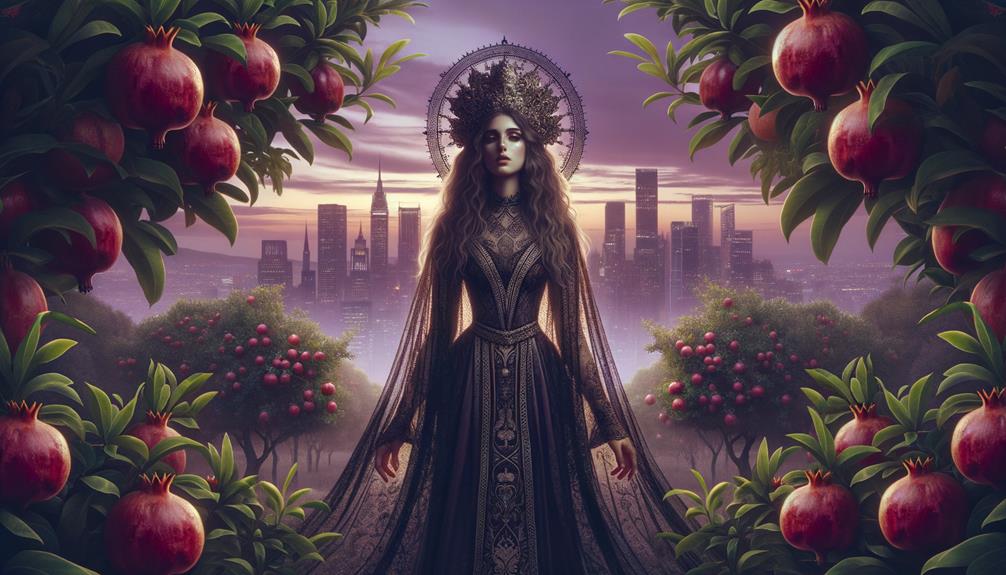
Persephone's story from ancient times still holds a significant place in today's literature, art, and cultural interpretations. In the modern world, she's often viewed not just as an embodiment of fertility and natural abundance, but also as a representation of female strength and resilience in challenging power dynamics.
There are three main elements that contemporary versions of her tale tend to focus on:
- First, they emphasize Persephone's ability to make decisions for herself, portraying her as an active participant in her own story rather than just a helpless victim.
- Second, they underline her symbolic role as a divinity of both life and death, highlighting the two-sided nature of her character.
- Lastly, they represent her as a figure who can handle power dynamics with bravery and elegance, demonstrating her resilience.
These elements all contribute to the multi-faceted persona of Persephone, making her an engaging character in the present cultural context.
Artistic Representations of Persephone

When we talk about Persephone in art, it's really fascinating to see how varied her depictions are. She's not just shown as the Queen of the Underworld, but also as a reflection of the changing seasons and a symbol of bountiful harvests. Her image is constantly evolving in art, from ancient times to the present day, mirroring our ever-growing knowledge of her myth and what it represents.
Persephones Iconography in Art
When you dive into the art that depicts Persephone, you'll notice she's often represented in two ways – as a goddess of crops and as the Queen of the Underworld. The art often shows her clutching bundles of grain and a burning torch, signifying these roles. You can see this same duality in the Homeric Hymn to Demeter, where she's also referred to as Kore, the young girl.
- Art emphasizes her role in farming by often including Triptolemos, a hero known for his grain-growing skills, in the picture.
- In the Eleusinian Mysteries, which are ancient ceremonies about life and death, she's commonly shown with her mother, Demeter, underlining their tight bond.
- Her yearly journey back from the underworld is often associated with the renewal of spring in art, representing the cycle of nature.
Through this artistic symbolism, we get a clear picture of the complex character that Persephone is in mythology.
Influential Persephone Artworks
Let's dive right into some of the most impactful pieces of art that beautifully depict Persephone's dual nature and her pivotal role in Greek mythology. Married to Hades, Persephone reigns as the Queen of the Underworld for part of the year. This aspect of her life is vividly portrayed in numerous artworks. In these artistic representations, you'll often see Persephone holding bundles of grain and a burning torch. These symbols speak volumes about her influence on agriculture and her dominion in the Underworld.
| Art Piece | What it Represents |
|---|---|
| Persephone with Demeter and Triptolemos | Showcases family ties and the importance of agriculture |
| Persephone's Annual Return | Represents the unending cycle of life and growth |
| Persephone as the Underworld Queen | Illustrates her overseeing the souls of figures like Herakles and Orpheus |
These artworks offer a glimpse into Persephone's mythology, where she and Hades jointly rule, and she emerges as a symbol of life and death.
Modern Interpretations of Persephone
Let's take a moment to chat about how modern artists interpret Persephone. She's still a big deal in the art world, often seen as a touching symbol of life's cycle – birth, death, and rebirth. The artwork really brings her underworld ties to life, showing her off as both the queen of the dark and the herald of spring.
- Details like pomegranates show that she rules the underworld, while flowers hint at her return with the spring. It's all about the cycle of life, death, and rebirth.
- The shift from young girl to queen is shown through bright colors and detailed designs, showcasing her maturity and tenacity.
- Her strength as the underworld's queen is often highlighted, emphasizing the theme of power and standing tall against odds.
The way artists portray Persephone is quite moving. They bring to life a story that never gets old – one of standing tall, growing, and staying resilient.
Frequently Asked Questions
What Did Persephone Do as Queen of the Underworld?
You know, being the queen of the underworld wasn't an easy job. It was me, Persephone, and Hades, sharing the task of managing the spirits of the departed. A big part of my gig was influencing the old-time rites of regeneration in Eleusis. And then there was this whole thing about my time in the underworld symbolizing the cycle of death and rebirth in nature. Quite an intense role, don't you think?
Who Is the Queen of the Underworld Goddess?
You're asking about me, right? Well, let's chat about it. My name is Persephone and, in the stories of Greek mythology, I'm known as the Queen of the Underworld. It's my job to oversee the world of the dead, and I do so by maintaining the delicate balance between life and death. You could say that I'm a symbol of the cyclical nature of life, much like the changing seasons.
Who Is the Greek Goddess Queen of the Underworld?
I know a thing or two about Greek mythology, even the spooky stuff. There's this goddess, right? She's the queen of the Underworld, ruling by Hades' side. But, hey, her name? That's something only whispered in hushed tones, a secret hidden in the dark.
Did Persephone Have a Child With Hades?
Well, you might be curious if Persephone and Hades, from the lore of Greek mythology, ever had a baby together. The answer is no. This tale primarily highlights Persephone's reign as the queen of the underworld rather than her potential role as a mother.

